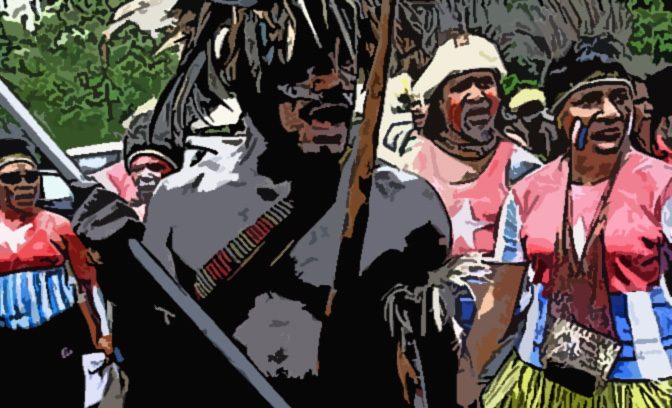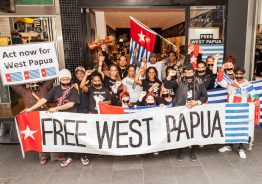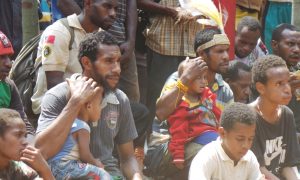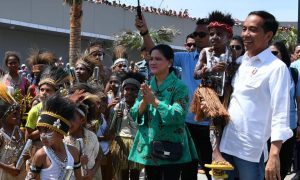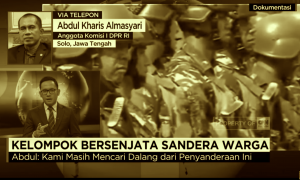After half a century of incorporation as part of Indonesia and following a period of generally declining violence in the half island of West Papua, the past year has seen a marked upsurge in Papuan-initiated violence. This increased violence appears to demonstrate that, even after so much time, anti-Indonesian sentiment is as strong as ever.
Factors contributing to this increased violence include greater Indonesian inroads – literally – into the territory and a higher level of unification and organisation by West Papuan separatists. But, not least, there is also a rising tide of anger over deeply ingrained and institutionalised Indonesian racism by other Indonesians towards West Papuan Melanesians.
All of this anti-Indonesian sentiment is built on Indonesia’s incorporation of West Papua, in practice from 1963 and formally via a deeply controversial ‘vote’, at gunpoint, by a little more than a thousand village leaders in 1969. The armed resistance to Indonesia’s occupation began in the mid-1960s and, at different times, has seen a series of massacres of West Papuans on top of a background of routine repression, the migration of over a million Indonesians to the half island, and the often environmentally destructive exploitation of its natural resources.
In a bid to quell simmering unrest, West Papua was granted ‘special autonomy’ in 2001. However, while this resulted in a few more West Papuans getting government jobs, extra funding generated under the ‘autonomy’ legislation was largely syphoned off, and it did not create any greater functional autonomy in practice. The hollowness of this gesture was compounded by the later division of West Papua into two provinces, Papua and West Papua, initially with a plan for a third, in contravention of the ‘special autonomy’ legislation.
Indonesian Inroads
When President Joko Widodo came to power five years ago, he promised to resolve continuing grievances in West Papua. His first attempt was to open the territory to more outsiders. This was immediately countermanded by his own military.
Looking for structural reasons for discontent, Widodo’s advisers decided that despite West Papua’s substantial contribution to the Indonesian economy, Melanesian West Papuan discontent was driven by their low level of economic development. The territory has Indonesia’s highest poverty rate, at around 28 per cent, and a third are illiterate – double the next nearest province. With about 40 per cent of West Papua’s population of four million being non-Melanesian, and the main economic beneficiaries, this means that the poverty and illiteracy rate among Melanesian West Papuans is proportionately even higher.
To address this, Widodo authorised new infrastructure projects, including road works into remote areas. This was intended to facilitate greater trade.
However, the experience has been that greater access into remote regions means greater exploitation of natural resources, including illegal timber logging and external migration. The murder or disappearance of 17 Indonesian construction workers and a soldier in the Nduga area in December 2018 was a direct consequence of such unwanted road works.
Separatist Unification
This attack was quickly claimed for the Free Papua Organisation (Organisasi Papua Merdeka, or OPM) and its West Papua National Liberation Army (Tentara Pembasaan Nasional Papua Barat, or TPNPB). However, it was carried out by a group with only a tenuous link to the OPM-TPNPB. The term ‘OPM’ has not reflected the wider West Papuan resistance for many years.
The status of the ‘OPM’ is compromised by the existence of a larger and more coherent organisation, the United Liberation Movement for West Papua (ULMWP), which is recognised by the pro-West Papua Melanesian Spearhead Group of countries. The ULMWP was formed in 2014 in response to concerns that West Papuans lacked a united voice.
West Papua worries
Why West Papua remains a sore point in the relationship between Canberra and Jakarta.
The ULMWP is comprised of West Papua’s three largest coalitions, the West Papua National Coalition for Liberation, the National Federal Republic of West Papua and the National Parliament of West Papua. Benny Wenda was elected as chair of the ULMWP in December 2017. It was Wenda who, in 2017, organised a petition signed by some 1.8 million West Papuans calling for a referendum on independence that was presented to the United Nations.
Meanwhile, civil society groups such as the National Committee for West Papua (KNPB), which is closely associated with the ULMWP, proposed making West Papua ungovernable in order to bring Indonesia to the negotiating table.
Competition for higher level political organisation, and the KNPB’s ‘ungovernability’ plan, provided a framework for the September rioting. These riots led to a claimed 33 or more West Papuan deaths (West Papuans claimed more than 40) and the deaths of more than a dozen Indonesians.
Institutionalised Racism
The trigger for those events was, however, continued mistreatment by Indonesian authorities, including a school teacher who called a Melanesian pupil ‘monkey’. The subsequent student protest was met by the usual heavy-handed paramilitary police response.
These events, in the capital Jayapura and regional centre Wamena, followed rioting the month before over West Papuan university students in the Javanese city of Surabaya being attacked by police and a pro-Jakarta mob.
Melanesian West Papuans are viewed by most Indonesians as being culturally and intellectually inferior, a view that permeates Indonesia’s government and even its universities. Indonesian soldiers and police have routinely treated West Papuans with greater brutality than meted out to other Indonesians.
While thousands of migrants from Indonesia have now fled West Papua, thousands more Indonesian soldiers and paramilitary police have arrived. Disturbingly, West Papua has also seen an influx of Islamist jihadi groups, including the Islamic State-linked Jamaah Ansharut Daulah (JAD), bent on revenge.
JAD is a successor organisation to Jemaah Islamiyah, founded by Abu Bakar Basyir in 2015. It was held to be responsible for the 2018 Surabaya bombings and the 2019 Jolo Cathedral bombings and is proscribed by Australia as a terrorist organisation.
Another, Islamist group, the Islamic Defenders Front (FPI), has also called for jihad in West Papua. The Islamic Jihad Front (FJI) has openly called for violent jihad in West Papua, establishing a jihadist ‘reception centre’ in Wamena.
Pro-Jakarta militias have been active in West Papua since the early 2000s and have usually worked in cooperation with the local police or army. It was such militias, along with police and the army, that were responsible for some of the deaths of West Papuans in September.
Paths Forward
West Papuans have been calling for United Nations intervention for decades, but more loudly since the killing of the road workers in 2018. The UN’s Commissioner for Human Rights, Michelle Bachelet, has said she wants to travel to West Papua to conduct investigations but, to date, has been refused permission to enter by the Indonesian government.
President Widodo has since said that he was prepared to meet with the ULMP’s Benny Wenda. Wenda said he would meet, but placed conditions on the meeting, which meant it has not yet happened. In any case, facing criminal charges and a high level of personal risk in Indonesia, Wenda would not be able to travel to Jakarta for such a meeting, which Widodo had proposed.
Widodo’s real problem, though, is that he lacks support in Indonesia’s legislature for a substantial political shift on West Papua. This is compounded by a large section of Indonesian society, including its army, being deeply opposed to loosening Jakarta’s still tight grip. With former generals Wiranto and Riyamizard Rycudu being in turn Widodo’s Politics and Security Minister and Defense Minister, the president has boxed himself into a small political corner.
On the West Papuan side, the independence movement faces a number of hurdles, not least being the lack of complete unity of the independence movement. This has improved under the leadership of the ULMWP, but the continued assertion of primacy by the older, if smaller, OPM remains problematic.
Further, many West Papuans look to Timor-Leste for inspiration, but Timor-Leste was not recognised as part of Indonesia by the UN, which allowed for the UN facilitating the ballot for self-determination. West Papua is recognised by the UN as part of Indonesia, which complicates any potential involvement.
Finally, there is a view that, if independence movements are to be successful, they must achieve not just a simple majority but, especially in highly contested environments, a super-majority, of two-thirds or more. To achieve less is to invite civil war.
West Papua’s indigenous population appear to be overwhelmingly united behind independence and would probably return a vote in the order of 80 to 90 per cent in favour should such a vote be held. The problem is that up to 40 per cent of West Papua’s population is not Melanesian and they would be likely to vote against independence.
The Indonesian military has always assumed it had primacy of responsibility for West Papuan political affairs. It has made clear that, should there be even a hint of such a vote, it would step in to stop that dead. The future for the troubled territory does not, then, look promising.
 Facebook
Facebook  Twitter
Twitter  Soundcloud
Soundcloud  Youtube
Youtube  Rss
Rss 